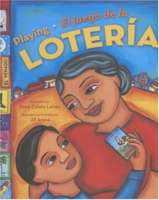
A boy has a good time attending a fair with his grandmother in San Luis de La Paz, Mexico, as she teaches him Spanish words and phrases and he teaches her English.
Read more about Playing Loteria in Volume 1, Issue 3 of WOW Review: Reading Across Cultures.
This book has been included in WOW’s Language and Learning: Children’s and Young Adult Fiction Booklist. For our current list, visit our Booklist page under Resources in the green navigation bar.
Featured in August 2023’s WOW Dozen for books about Language Learning and Communication.
- ISBN: 9780873588812
- Authors: Arena, Jill; Lainez, Rene Colato
- Published: 2005, Luna Rising
- Themes: Family, Games, languages, traditions
- Descriptors: Americas, Bilingual, Latinx in US, Mexico, Primary (ages 6-9), Realistic Fiction
- No. of pages: 32

As a child who grew up playing la loteria, I greatly enjoyed reading this book and taking in the colorful images. The dual-language nature of the text and its combination with a game based upon Spanish vocabulary lends itself well to encouraging students to build vocabulary in general—whether it be in another language or in multiple subjects. I agree with Carmen that the Spanish portion of the text looses some of the meaning that is being conveyed through the English portion. I was appreciative of the fact that the discussion of language was connected to identity and family relationships—a common theme throughout the literature about Latino children’s experiences. In addition, I was drawn to the use of Spanglish in the text, making me feel “at home” while reading.
The dual-language book Playing lotería/El juego de la lotería fits very well this month’s focus on bilingualism. It is one of those books that can grab children’s interests easily for its focus on play, especially the attention of children from Mexican background since the game lotería or Mexican bingo, is well known among Mexican and other Latin American children.
The book begins by presenting the dilemma many Latin American young children living in the United States face when they grow up with English as their first language or when they learn English and begin to forget Spanish, while their grandparents speak only Spanish. The boy protagonist felt insecure about his Spanish and did not want initially to spend summer time with his grandmother in Mexico because of this. The story has the potential to engage teachers and children in a discussion on bilingualism, its challenges and potential.
As a dual-language text, the story is told in English and Spanish. A main theme of the story relates to bilingualism and the author represents this them by incorporating some Spanish words into the English text; however, this strategy does not seem to work so well in the Spanish rendition of the story. The English text contains some Spanish words that correspond to the following semantic fields: family- the use of kinship terms: abuela (grandmother), mamá (mother), hijo (son); food- culinary terms such as carne asada, physical environment: (the feria); and the names of the cards. By the end of the story the boy begins to use two-word sentences in Spanish. The Spanish rendition of the story also contains some English; however, I think that the effect of the use of two languages is more successfully reached in the English than in the Spanish rendition. Something is lost in the Spanish rendition of the story because the boy protagonist, English dominant, is narrating in Spanish and quotes himself a couple of times speaking in English and others speaking in Spanish. Grandma’s learning of English is also lost because her English is translated most of the time into Spanish. The English text seems to represent better the characters’ use of the two languages. To be more effective, the Spanish version would have had to switch the linguistic situation of the characters and tell the story of a Spanish-dominant boy learning English. This change, though, would not work because the boy was visiting a Spanish-speaking grandma living in s Spanish-speaking country. The translators of the story definitely had a big challenge. In spite of these limitations, the Spanish text makes the story accessible to Spanish-speaking children. It offers Latin American children a new opportunity to read a culturally relevant text they can potentially connect with and that can motivate them to become avid readers while keeping learning and reading in two languages.
What do you think about the use of Spanish and English in this text? Did it work for you? Do you think that the dual-language nature of the book supports the story?
Charming story indeed! I think children will enjoy learning about loteria, the popular Mexican card game, while they learn some Spanish words.